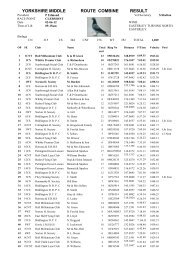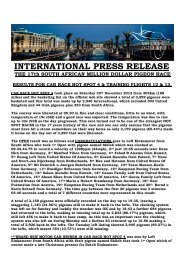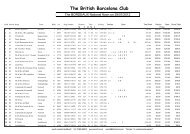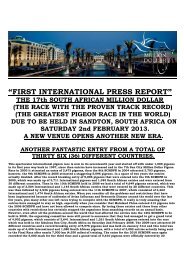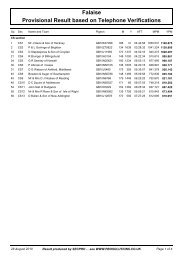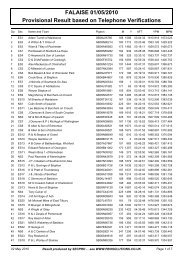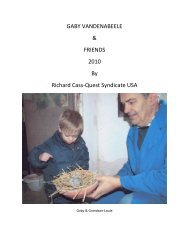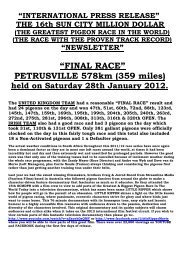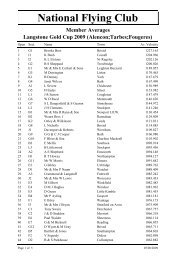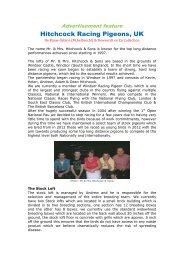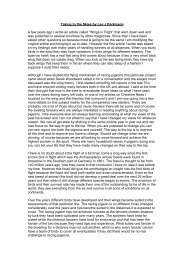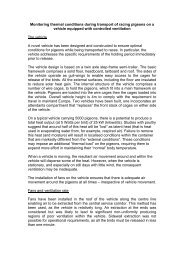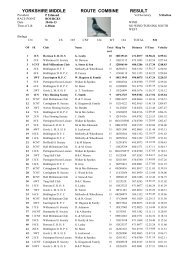February - Elimar Pigeon Services
February - Elimar Pigeon Services
February - Elimar Pigeon Services
Create successful ePaper yourself
Turn your PDF publications into a flip-book with our unique Google optimized e-Paper software.
Weaning Young Birds: Now is the time that I do my preparation for the weaning of my youngsters. This is<br />
something that I have done religiously since I first began to send youngsters to races from France in the<br />
year of their birth. Although I do not believe that we should be sending YBs to such races, at a time of the<br />
year when the daylight hrs. are not sufficient to allow liberations later in the morning when temperatures<br />
are suitable for 300 plus races, I do enjoy the challenge that they bring. My first step towards this, is to<br />
ensure that babies are weaned into baskets from the nest pan, so that they learn to eat and drink from the<br />
word go. I will take some photos and include them in the March article to show how I set this up. I am not<br />
saying that it makes the YBs win these races but it has helped me to time in many times when good<br />
fanciers have failed to get a bird on the day. I know that it is not the only contributory factor but for me, I<br />
believe it to be MAJOR. The preparation is the cleaning and disinfecting of the weaning crates so that they<br />
have ample time to dry out, at a time of the year when good drying days are sparse. The crates have a<br />
layer of about one inch of wood chips (Horse Bedding) with a small trough inside for food and an external<br />
trough for water. They are then fed and watered twice per day for one week before going into the race<br />
section when they are darkened from day 1. No youngster has it’s head dipped and any deterioration by<br />
the end of the week and a youngster would be disposed of. I can honestly say that this has only ever<br />
happened with three or four youngsters since 1992.<br />
The weaning of the youngsters is then followed by vaccination which I do when I have my full race team<br />
weaned into their race section. I think that the earlier the youngsters are vaccinated, the better and<br />
especially before they begin flying out. I 1991 when flying in partnership as Hulme and Knowles, the Ybs<br />
were left during the day and were not being vaccinated until May/June. The result was a confirmed case of<br />
paramyxo in the YBs and what followed was a night mare. It served as a very good lesson and I learned a<br />
great deal from the experience but I do not intend to repeat that naive mistake. As things transpired, once<br />
the all clear was received, we went on to win 1st Section NFC Bordeaux 598 miles and 2nd Section NFC<br />
Pau 700 miles with another 3 pigeons in the first 25 of the Section result. So as you can see it did not<br />
affect the OBs but the YBs did not race, a No. had to be killed and I never had any faith in the YBs born<br />
that year other than the summer bred youngsters that followed.<br />
Dehydration: The whole point of basket training the YBs at the point of weaning and the repeat refresher<br />
training from baskets, is to prevent or at least the the youngster the best chance of avoiding dehydration<br />
during transit. I also believe that the refresher training for old birds is worth while at the early stages of<br />
each season. I will include a photo of how I do this in the March article. There is also one more point to<br />
make on the subject of dehydration, which I meant to cover earlier and that is the care of stock birds when<br />
feeding youngsters of around seven to fourteen days old. Obviously with the transition from feeding soft<br />
milk to hard corn, the parent bird has to use water as it’s transport agent for the feeding. During this time I<br />
like to supplement the parent birds with an additive in their water for five or six days. The additive is a<br />
combination of electrolytes with vitamins, trace elements and amino acids. Given at the rate of two<br />
tablespoons per litre of water, the benefits in the growth of the youngsters and the health of the parents is<br />
very noticeable. The product that I favour most id Belgasol from De Weerd in Holland but you could use<br />
any similar product or indeed make up your own. The cost doesn’t need to be silly and the benefit is<br />
significant.<br />
Above sketch and photos are the actual skeleton of a racing pigeon, perhaps not quite as some may imagine.



